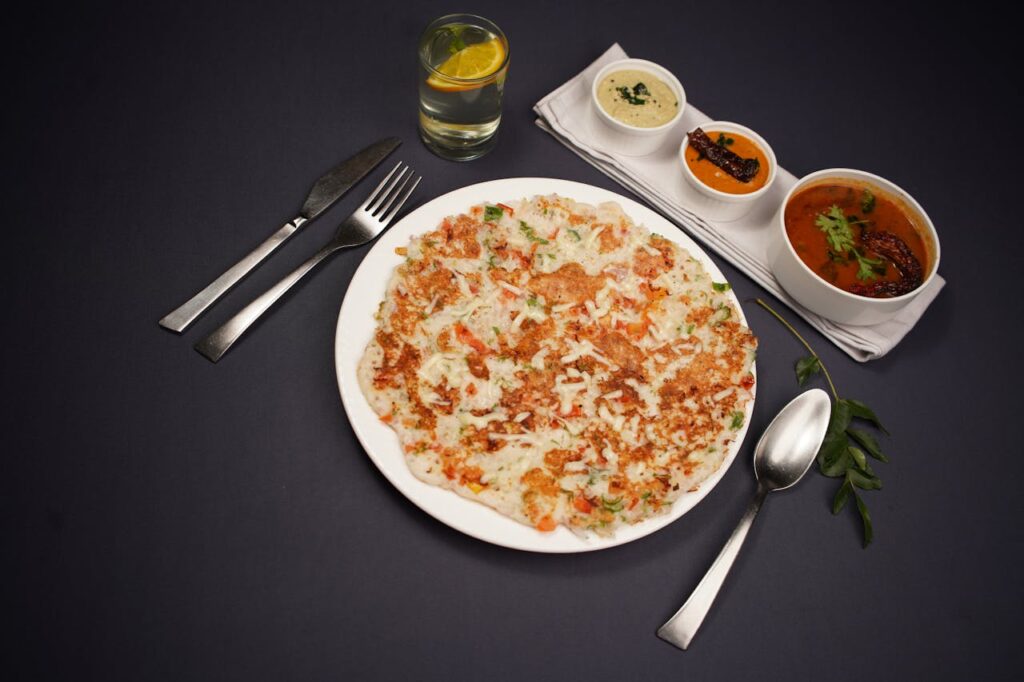
Ingredients
For the Batter:
- 1 cup of rice (ideally parboiled rice or dosa rice)
- 1/4 cup of urad dal (split black gram)
- 1/4 teaspoon of fenugreek seeds (optional but adds flavor)
- Salt to taste
- Water (adjust as needed to get the correct consistency)
For the Topping (Optional, depending on preference):
- 1 small onion, finely chopped
- 1 small tomato, finely chopped
- 1 green chili, finely chopped (optional, adjust based on spice preference)
- 1/4 cup of chopped coriander leaves (fresh cilantro)
- 1/4 cup of grated carrot
- 1/4 cup of bell pepper, finely chopped (optional)
- 1 tablespoon of oil or ghee (clarified butter) for cooking
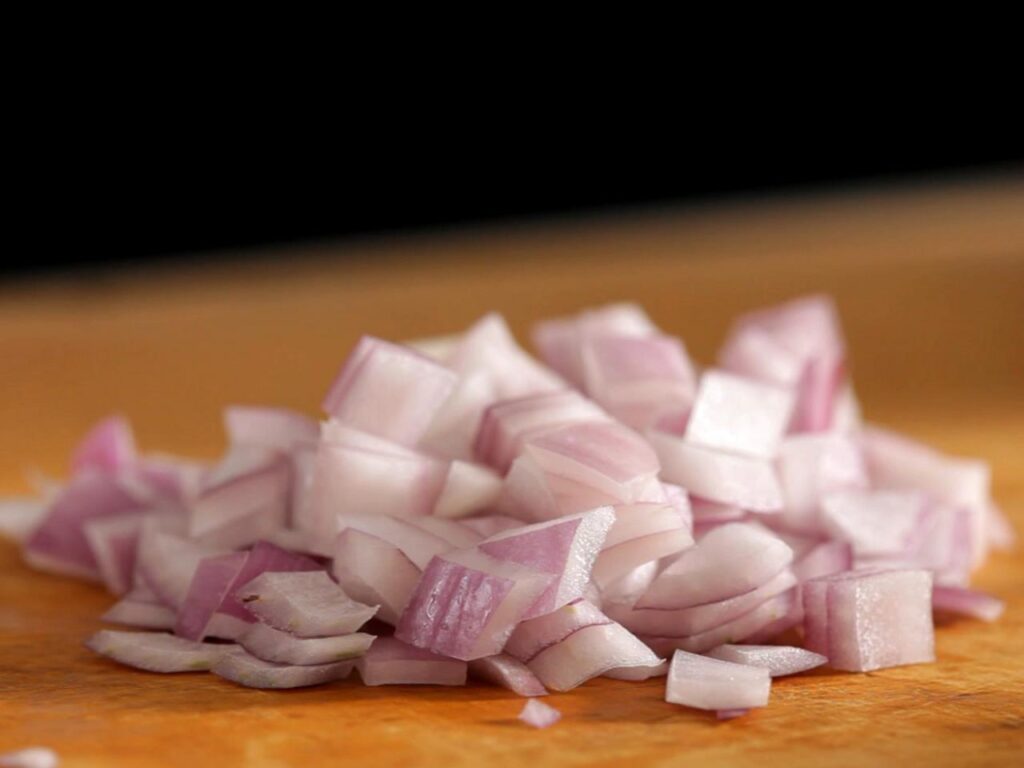
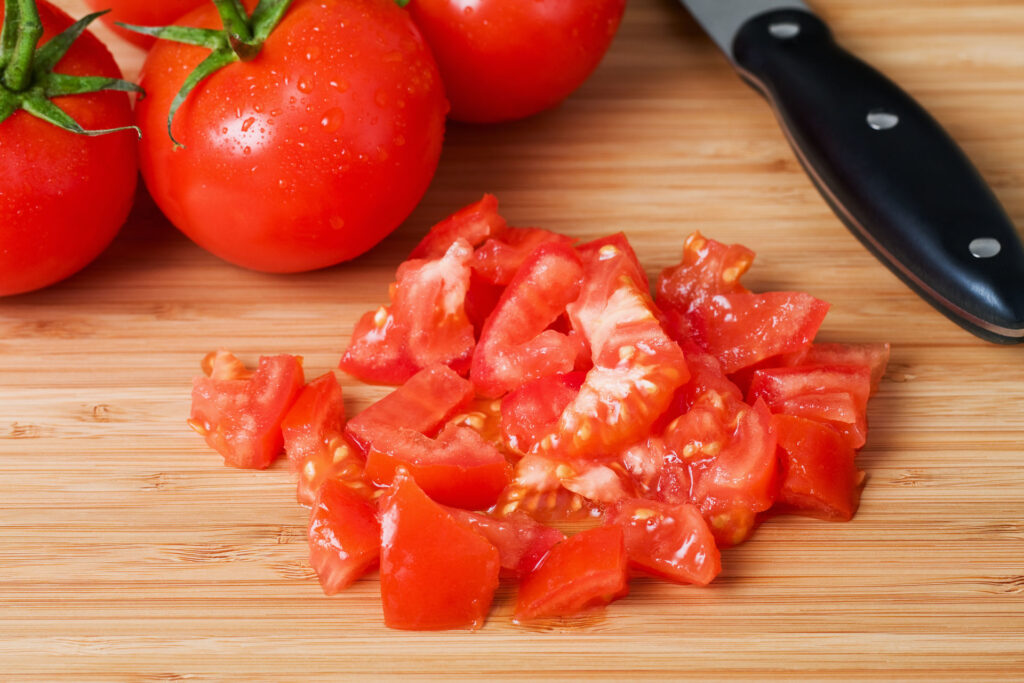
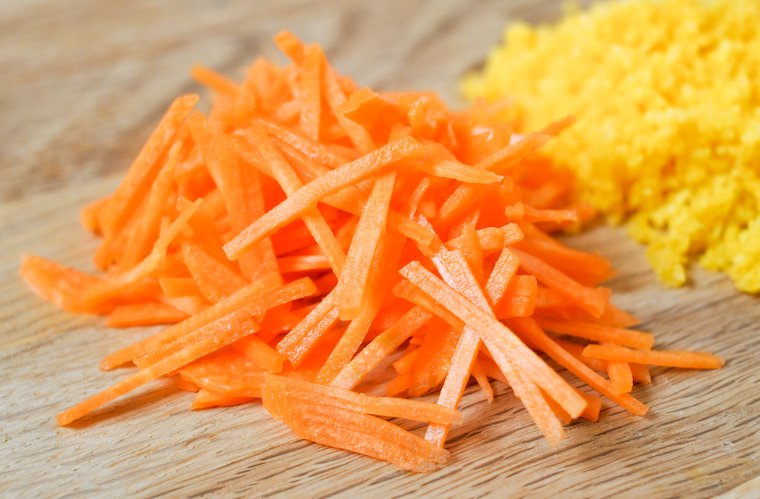
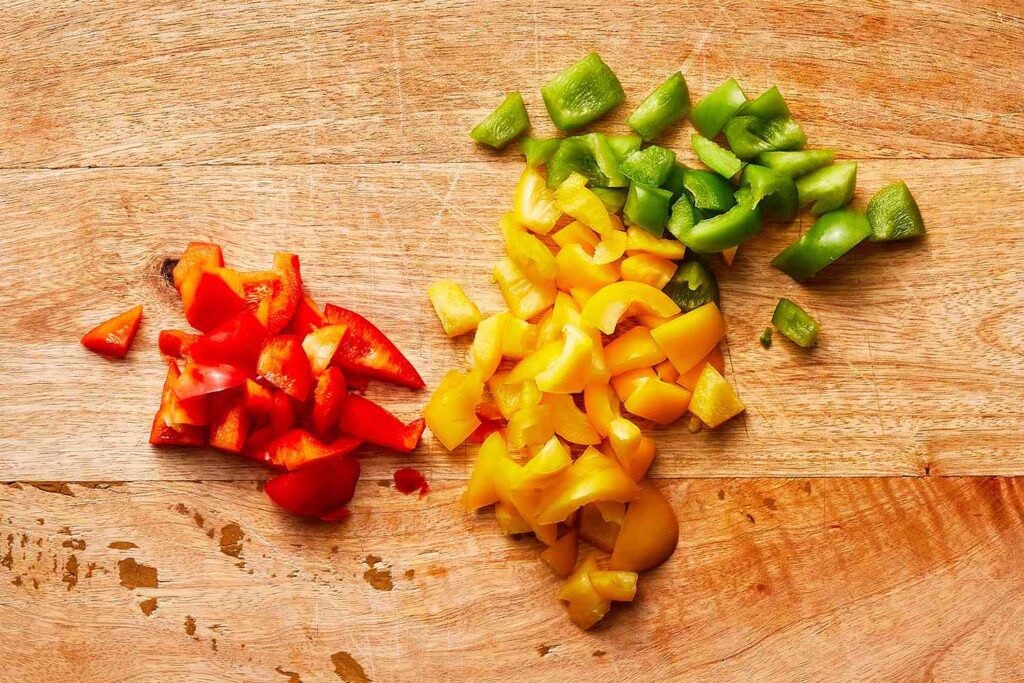
For Serving:
- Coconut chutney
- Tomato chutney
- Sambar (lentil soup)
- Pickles
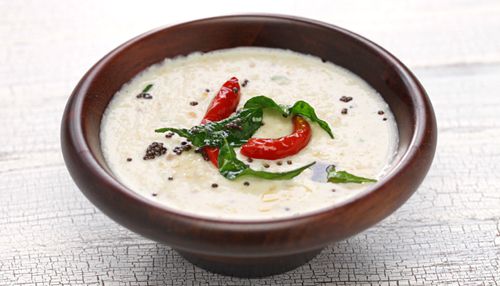
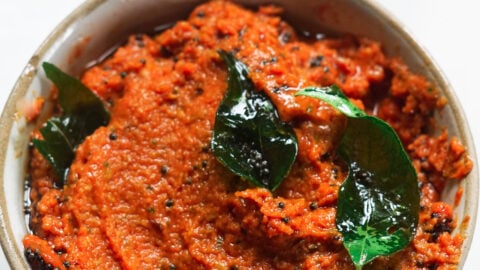
Preparation
Step 1: Soaking the Rice and Dal
The key to making soft and fluffy uttapam lies in properly soaking and fermenting the batter. For authentic uttapam, rice and dal need to be soaked separately to ensure even fermentation.
- Wash the Rice and Dal: Start by thoroughly washing the rice and urad dal. This removes excess starch and ensures a smooth batter.
- Soaking: Soak the rice and urad dal separately for 4 to 6 hours, or if possible, overnight. Additionally, soak the fenugreek seeds with the urad dal for added flavor and ease of grinding.
- Tip: If you’re in a hurry, you can soak the rice and dal for about 2 hours, but the texture of the batter may not be as ideal as when soaked for longer.
Step 2: Grinding the Batter
Once the rice and dal have soaked, the next step is to grind them into a smooth batter. Traditional methods involve using a wet stone grinder, but a high-power blender or food processor can also be used.
- Grind the Urad Dal: Start by grinding the urad dal and fenugreek seeds into a smooth, fluffy paste. Add water gradually to achieve the right consistency. The urad dal should be whipped and airy, which helps in fermentation and results in a soft texture for the uttapam.
- Grind the Rice: After the urad dal is ground, grind the rice into a slightly coarse batter. It’s essential to maintain some texture in the rice batter, which is what gives uttapam its characteristic thickness. The rice batter should not be too fine or too gritty, but somewhere in between.
- Mix the Rice and Dal: Combine the rice batter and urad dal paste in a large bowl. Use your hands to mix the two batters thoroughly. This helps to activate the fermentation process. Add salt to taste at this stage.
- Fermentation: Cover the bowl with a cloth or plastic wrap and let the batter ferment for 8 to 12 hours at room temperature. If you live in a warm climate, the batter will ferment faster, but in cooler climates, you may need to let it ferment for a longer period. The batter will rise, and you’ll notice a slight sour smell — a sign that the fermentation is complete.
- Check the Batter: After fermentation, the batter should be fluffy, airy, and slightly thick. It should be spreadable but not runny. If the batter is too thick, add a little water to adjust the consistency.
Step 3: Preparing the Toppings
While the batter is fermenting, you can prepare the toppings. Uttapam can be customized with a wide variety of vegetables, cheese, or even herbs, depending on your preference. Here are some common toppings:
- Onions: Finely chop a small onion and set it aside. Onions caramelize slightly while cooking and add a mild sweetness and crunch to the uttapam.
- Tomatoes: Chop a small tomato into small cubes. Tomatoes add juiciness and a slight tang to the dish.
- Chilies: If you enjoy spicy food, finely chop green chilies. You can adjust the quantity based on your spice tolerance.
- Herbs: Fresh coriander leaves (cilantro) add a refreshing burst of flavor. Chop them finely and set aside.
- Carrot: Grated carrots provide a crunchy texture and a mild sweetness, making them a popular addition to uttapam.
- Bell Pepper: If you like a more colorful uttapam, finely chop some bell peppers for a slight crunch and sweetness.
- Cheese (Optional): For a fusion twist, you can sprinkle some grated cheese (mozzarella or cheddar) over the batter. This melts into the uttapam, making it gooey and delicious.
- Other Toppings: Some variations include adding finely chopped spinach, peas, or even pineapple. Experiment with whatever vegetables you have on hand.
Step 4: Cooking the Uttapam
Cooking uttapam requires patience, as it’s not as quick as making dosa. However, it’s easy once you get the hang of it.
- Heat the Pan: Place a large, non-stick skillet or a traditional cast-iron tawa over medium heat. Allow the pan to get hot but not smoking.
- Grease the Pan: Lightly grease the pan with a few drops of oil or ghee. Using a paper towel, spread the oil evenly over the surface.
- Pour the Batter: Once the pan is hot, pour a ladle full of batter onto the center of the pan. Gently spread it into a thick, round pancake. The uttapam should be around 1/2 inch thick, so don’t spread it too thin. It will rise and expand as it cooks.
- Add the Toppings: Immediately sprinkle your choice of toppings — onions, tomatoes, chilies, coriander leaves, grated carrots, bell peppers, and cheese — onto the surface of the batter. Press them gently into the batter with the back of the spoon.
- Cook Covered: Cover the pan with a lid to trap the heat and allow the toppings to cook. Cook the uttapam on medium heat for about 3 to 4 minutes, or until the bottom turns golden brown and crispy.
- Flip the Uttapam: Using a spatula, carefully flip the uttapam to cook the other side for an additional 2 to 3 minutes, or until it’s golden brown and cooked through.
- Serve: Once both sides are golden and crispy, remove the uttapam from the pan. Serve it immediately while it’s still hot.
Step 5: Serving the Uttapam
Uttapam is best enjoyed when served fresh and hot. Traditionally, uttapam is served with a variety of chutneys and sambar. Here are some popular accompaniments:
- Coconut Chutney: This is a classic side dish for uttapam. It’s made from freshly grated coconut, green chilies, ginger, and a few other ingredients, ground into a smooth paste. Coconut chutney has a refreshing, creamy flavor that complements the slightly sour taste of fermented uttapam.
- Tomato Chutney: A tangy chutney made from tomatoes, onions, and spices, tomato chutney adds a burst of flavor that pairs wonderfully with the savory uttapam.
- Sambar: A rich lentil soup with vegetables and tamarind, sambar is another perfect accompaniment. Its tangy and spicy flavor balances the soft and savory taste of the uttapam.
- Pickles: For an added punch, serve uttapam with some traditional Indian pickles, such as mango or lime pickle. These pickles provide a spicy and tangy contrast.
Variations of Uttapam
While the basic uttapam recipe is always delicious, there are plenty of variations you can try. Here are some ideas:
- Cheese Uttapam: Add a generous amount of grated cheese (mozzarella, cheddar, or even paneer) on top of the batter just before flipping. This creates a cheesy, gooey uttapam that’s irresistible.
- Methi (Fenugreek) Uttapam: Add finely chopped fenugreek leaves (methi) to the batter. This version has a slightly bitter taste but is packed with nutrients and is considered healthy.
- Mixed Vegetable Uttapam: You can use a variety of vegetables such as peas, carrots, beans, and spinach. The combination of different veggies adds color, flavor, and crunch to the uttapam.
- Sweet Uttapam: For a twist, make a sweet version by adding sugar or jagg.
